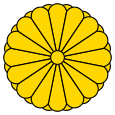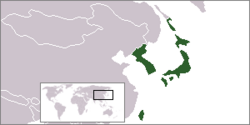Empire of Japan
|
|||||||||||||||||||||||||||||||||||||||||||||||||||||||||||||||||||||||||||||||||||||||||||||||||
The Empire of Japan (Kyūjitai: 大日本帝國; Shinjitai: 大日本帝国; pronounced Dai Nippon Teikoku; literally Great Imperial Japan or Great Empire of Japan, officially Great Japan, Empire of Greater Japan or Greater Japanese Empire; more widely known as Imperial Japan or the Japanese Empire) was a Japanese political entity that existed during the period from the Meiji Restoration in 1868 until its defeat in World War II in 1945.
The country's rapid industrialization and militarization under the slogan Fukoku Kyōhei (富国強兵? "Enrich the Country, Strengthen the Military"), led to its emergence as a world power eventually culminating with its membership in the Axis alliance and the conquest of a large part of the Asia-Pacific region.
Despite several large scale military successes during the first half of the Pacific War, the Empire of Japan, after suffering numerous defeats as the war progressed, and the atomic bombings of Hiroshima and Nagasaki, surrendered to the Allies on September 2, 1945. A period of occupation by the Allies followed the surrender and dissolution of the Empire, and a new constitution was created with American involvement. American occupation and reconstruction of the country continued well into the 1950s eventually forming the current modern Japan.
The Emperors during this time, which spanned the Meiji, Taishō and Shōwa eras, are now known by their posthumous names which coincide with those era names: Emperor Meiji (Mutsuhito), Emperor Taishō (Yoshihito) and Emperor Shōwa (Hirohito).
Terminology
Although the empire is commonly referred to as "the Japanese Empire" or "Imperial Japan" in English, the literal translation from Kanji is Greater Japanese Empire (Dai Nippon Teikoku). The nomenclature Empire of Japan had existed since the feudal anti-shogunate domains, Satsuma and Chōshū, which founded their new government during the Meiji Restoration, with the intention of forming a modern state to resist western domination.
Meiji Restoration
After two centuries, the seclusion policy, or Sakoku, under the shoguns of the Edo period came to an end when the country was forced open to trade by the Convention of Kanagawa in 1854.
The following years had seen increased foreign trade and interaction, commercial treaties between the Tokugawa Shogunate and Western countries were signed. In large part due to the humiliating terms of these Unequal Treaties, the Shogunate soon faced internal hostility, which materialized into a radical, xenophobic movement, the sonnō jōi (literally "Revere the Emperor, expel the barbarians").[1]
In March 1863 the "Order to expel barbarians" was issued. Although the Shogunate had no intention of enforcing the order, it nevertheless inspired attacks against the Shogunate itself and against foreigners in Japan. The Namamugi Incident during 1862 led to the murder of an Englishman, Charles Lennox Richardson by a party of samurai from Satsuma. The British demanded reparations and responded by bombarding the port of Kagoshima in 1863, for his death the Tokugawa government agreed to pay an indemnity.[2] Shelling of foreign shipping in Shimonoseki and attacks against foreign property led to the Bombardment of Shimonoseki by a multinational force in 1864.[3] The Chōshū clan also carried out the failed Hamaguri Rebellion. The Satsuma-Chōshū alliance was established in 1866 to combine their efforts to overthrow the Tokugawa bakufu. In early 1867, Emperor Komei died of smallpox and was replaced by his son Mutsuhito (Meiji).
On November 9, 1867 Tokugawa Yoshinobu resigned his post and authorities to the emperor, agreeing to "be the instrument for carrying out" imperial orders.[4] The Tokugawa Shogunate had ended.[5] However, while Yoshinobu's resignation had created a nominal void at the highest level of government, his apparatus of state continued to exist. Moreover, the shogunal government, the Tokugawa family in particular, would remain a prominent force in the evolving political order and would retain many executive powers,[6] a prospect hard-liners from Satsuma and Chōshū found intolerable.[7]

On January 3, 1868, Satsuma-Chōshū forces seized the imperial palace in Kyoto, and the following day had the fifteen-year-old Emperor Meiji declare his own restoration to full power. Although the majority of the imperial consultative assembly was happy with the formal declaration of direct rule by the court and tended to support a continued collaboration with the Tokugawa, Saigō Takamori threatened the assembly into abolishing the title "shogun" and order the confiscation of Yoshinobu's lands.[8]
On January 17, 1868, Yoshinobu declared "that he would not be bound by the proclamation of the Restoration and called on the court to rescind it."[9] On January 24, Yoshinobu decided to prepare an attack on Kyoto, occupied by Satsuma and Chōshū forces. This decision was prompted by his learning of a series of arsons in Edo, starting with the burning of the outworks of Edo Castle, the main Tokugawa residence.
Boshin War
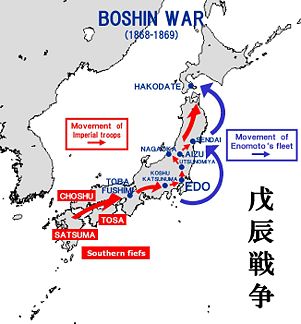
The Boshin War (戊辰戦争 Boshin Sensō?) was fought between January 1868 and May 1869. The alliance of samurai from southern and western domains and court officials had now secured the cooperation of the young Emperor Meiji who ordered the dissolution of the two-hundred-year-old Tokugawa Shogunate. Tokugawa Yoshinobu launched a military campaign to seize the emperor's court at Kyoto. However, the tide rapidly turned in favor of the smaller but relatively modernized imperial faction and resulted in defections of many daimyo to the Imperial side; the Battle of Toba-Fushimi being a decisive victory in which a combined army from Chōshū, Tosa and Satsuma domains defeated the Tokugawa army. A series of battles were then fought in pursuit of supporters of Shogunate; Edo surrendered to the Imperial forces and afterwards Yoshinobu personally surrendered. Yoshinobu was stripped of all his power by Emperor Meiji and most of Japan accepted the emperor's rule.
Pro-Tokugawa remnants, however, then retreated to northern Honshū (Ouetsu Reppan Domei) and later to Ezo (present day Hokkaidō), where they established the breakaway Republic of Ezo. An expeditionary force was despatched by the new government and the Ezo Republic forces were overwhelmed. The siege of Hakodate came to an end in May 1869 and the remaining forces surrendered.
Five Charter Oath
The Charter Oath was made public at the enthronement of Emperor Meiji of Japan on April 7, 1868. The Oath outlined the main aims and the course of action to be followed during Emperor Meiji's reign, setting the legal stage for Japan's modernization.[10]
The aims of the Meiji leaders were also to boost morale and win financial support for the new government. Its five provisions consisted of:
- Establishment of deliberative assemblies.
- Involvement of all classes in carrying out state affairs.
- The revocation of sumptuary laws and class restrictions on employment.
- Replacement of "evil customs" with the "just laws of nature".
- An international search for knowledge to strengthen the foundations of imperial rule.
Meiji era (1868-1912)


Several prominent writers under the constant threat of assassination from their political foes, such as Fukuzawa Yukichi were influential in convincing Japanese people for westernization. For instance some of his works that were well known were "Conditions in the West", "Leaving Asia", and "An Outline of a Theory of Civilization" that detailed Western society and his own philosophies. In the Meiji Restoration period, military and economic power was well emphasized. Military strength became the means for national development and stability. Imperial Japan became the only non-Western world power and a major force in east and southeast Asia in less than 30-50 years as a result of industrialization and economic development.
As one writer Albrecht Fürst von Urach comments in his booklet "The Secret of Japan's Strength,"
| “ | The rise of Japan to a world power during the past 80 years is the greatest miracle in world history. The mighty empires of antiquity, the major political institutions of the Middle Ages and the early modern era, the Spanish Empire, the British Empire, all needed centuries to achieve their full strength. Japan's rise has been meteoric. After only 80 years, it is one of the few great powers that determine the fate of the world. | ” |

The sudden westernization, once it was adopted, changed almost all arenas of Japanese society ranging from language, etiquette, clothes, judicial and political system, armaments, arts, etc. Japanese government sent students to Western countries to observe and learn their practices as well as paying foreign scholars to come to Japan to educate the populace, the so called "foreign advisors" coming in from variety of studies. For instance the judicial system and constitution were largely modeled on that of Germany. It also outlawed customs linked to Japan's feudal past, such as displaying and wearing katana in the public and top knot both of which were characteristic of the samurai class, which were abolished all together with the caste system. This would later bring the Meiji government into conflict with the Samurai.
Moreover the Meiji government brought numerous armaments, ships and such that to build their conscription based national army (Imperial Japanese Army) and navy (Imperial Japanese Navy).
Constitution

The constitution also recognized the aforementioned acknowledgment of a need for change and modernization after removal of the shogunate:
| “ | We, the Successor to the prosperous Throne of Our Predecessors, do humbly and solemnly swear to the Imperial Founder of Our House and to Our other Imperial Ancestors that, in pursuance of a great policy co-extensive with the Heavens and with the Earth, We shall maintain and secure from decline the ancient form of government...In consideration of the progressive tendency of the course of human affairs and in parallel with the advance of civilization, We deem it expedient, in order to give clearness and distinctness to the instructions bequeathed by the Imperial Founder of Our House and by Our other Imperial Ancestors, to establish fundamental laws.... | ” |
Imperial Japan was founded, de jure, after the 1889 signing of Constitution of the Empire of Japan. The constitution formalized much of its political structure and gave many responsibilities and powers to the Emperor.
Article 4. The Emperor is the head of the Empire, combining in Himself the rights of sovereignty, and exercises them, according to the provisions of the present Constitution.
Article 6. The Emperor gives sanction to laws, and orders them to be promulgated and executed.
Article 11. The Emperor has the supreme command of the Army and Navy.[12]
Although it was in this constitution that the title Empire of Japan was officially used for the first time, it was not until 1936 that this title was legalized. Until then, the names "Nippon" (日本; Japan), "Dai-Nippon" (大日本; Greater Japan), "Dai-Nippon/-Nihon Koku" (日本國; State of Japan), "Nihon Teikoku" (日本帝國; Empire of Japan) were all used.
Economic development

The process of modernization was closely monitored and heavily subsidized by the Meiji government, enhancing the power of the great zaibatsu firms such as Mitsui and Mitsubishi. Hand in hand, the zaibatsu and government guided the nation, borrowing technology from the West. Japan gradually took control of much of Asia's market for manufactured goods, beginning with textiles. The economic structure became very mercantilistic, importing raw materials and exporting finished products — a reflection of Japan's relative scarcity of raw materials.
Economic reforms included a unified modern currency based on the yen, banking, commercial and tax laws, stock exchanges, and a communications network. Establishment of a modern institutional framework conducive to an advanced capitalist economy took time but was completed by the 1890s. By this time, the government had largely relinquished direct control of the modernization process, primarily for budgetary reasons. Many of the former daimyo, whose pensions had been paid in a lump sum, benefited greatly through investments they made in emerging industries.
The government was initially involved in economic modernization, providing a number of "model factories" to facilitate the transition to the modern period. After the first twenty years of the Meiji period, the industrial economy expanded rapidly until about 1920 with inputs of advanced Western technology and large private investments.
Japan emerged from the Tokugawa-Meiji transition as the first Asian industrialized nation. From the onset, the Meiji rulers embraced the concept of a market economy and adopted British and North American forms of free enterprise capitalism. Rapid growth and structural change characterized Japan's two periods of economic development after 1868. Initially, the economy grew only moderately and relied heavily on traditional Japanese agriculture to finance modern industrial infrastructure. By the time the Russo-Japanese War began in 1904, 65% of employment and 38% of the gross domestic product (GDP) was still based on agriculture, but modern industry had begun to expand substantially. By the late 1920s, manufacturing and mining contributed to 23% of GDP, compared with the 21% for all of agriculture. Transportation and communications developed to sustain heavy industrial development.
From 1894, Japan built an extensive empire that included Taiwan, Korea, Manchuria, and parts of northern China. The Japanese regarded this sphere of influence as a political and economic necessity, preventing foreign states from strangling Japan by blocking its access to raw materials and crucial sea-lanes. Japan's large military force was regarded as essential to the empire's defense and prosperity through obtaining natural resources, which the Japanese islands were lacking in.
First Sino-Japanese War
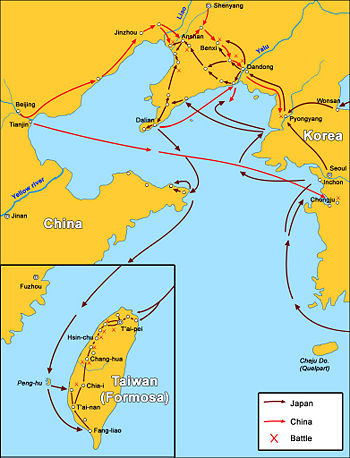
Prior to its engagement in World War I, the Empire of Japan fought in two significant wars after its establishment following the Meiji Revolution. The first was the First Sino-Japanese War, fought between 1894 and 1895. The war revolved around the issue of control and influence over Korea under the rule of the Joseon Dynasty. A peasant rebellion led to a request by the Korean government for China to send troops in to stabilize the region. The Empire of Japan responded by sending their own force to Korea and installing a puppet government in Seoul. China objected and war ensued. In a brief affair with Japanese ground troops routing Chinese forces on the Liaodong Peninsula, and the near destruction of the Chinese navy in the Battle of the Yalu River, China was forced to sign the Treaty of Shimonoseki, which ceded parts of Manchuria and the island of Formosa to Japan (see Taiwan under Japanese rule and Japanese Invasion of Taiwan (1895)). After this war, regional dominance shifted from China to Japan.
Russo-Japanese War
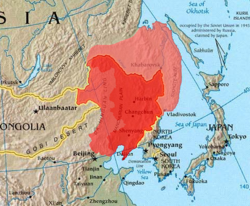

The Russo-Japanese War was a conflict for control of Korea and parts of Manchuria by the Russian Empire and Empire of Japan that took place from 1904 to 1905. The war is significant as the first modern war where an Asian country defeated a European power. The victory greatly raised Japan's measure in the world of global politics. The war is marked by the Japanese rebuff of Russian interests in Korea, Manchuria, and China, notably, the Liaodong Peninsula, controlled by the city of Port Arthur.
Originally, in the Treaty of Shimonoseki, Port Arthur had been given to Japan. This part of the treaty was overruled by Western powers, which gave the port to the Russian Empire, furthering Russian interests in the region. These interests came into conflict with Japanese interests. The war began with a surprise attack on the Russian Eastern fleet stationed at Port Arthur, which was followed by the Battle of Port Arthur. Those elements that attempted escape were defeated by the Japanese navy under Admiral Togo Heihachiro at the Battle of the Yellow Sea. A year later, the Russian Baltic fleet arrived only to be annihilated in the Battle of Tsushima. While the ground war did not fare as poorly for the Russians, the Japanese army was significantly more aggressive than their Russian counterparts and gained a political advantage that accumulated with the Treaty of Portsmouth negotiated in the United States by the American president Theodore Roosevelt. As a result, Russia lost the part of Sakhalin Island south of 50 degrees North latitude (which became the Karafuto Prefecture), as well as many mineral rights in Manchuria. In addition, Russia's defeat cleared the way for Japan to annex Korea outright in 1910.
Taishō era (1912-1926)
World War I



Japan entered World War I in 1914, seizing the opportunity of Germany's distraction with the European War and wanting to expand its sphere of influence in China. Japan declared war on Germany in August 23, 1914 and quickly occupied German-leased territories in China's Shandong Province and the Marianas, Caroline, and Marshall Islands in the Pacific which were part of German New Guinea. The siege of Tsingtao, a swift invasion in the German colony of Jiaozhou (Kiautschou) proved successful and the colonial troops surrendered on 7 November 1914.
With Japan's Western allies, notably the United Kingdom, heavily involved in the war in Europe, it sought further to consolidate its position in China by presenting the Twenty-One Demands to China in January 1915. Besides expanding its control over the German holdings, Manchuria, and Inner Mongolia, Japan also sought joint ownership of a major mining and metallurgical complex in central China, prohibitions on China's ceding or leasing any coastal areas to a third power, and miscellaneous other political, economic, and military controls, which, if achieved, would have reduced China to a Japanese protectorate. In the face of slow negotiations with the Chinese government, widespread anti-Japanese sentiment in China, and international condemnation, Japan withdrew the final group of demands, and treaties were signed in May 1915.
Siberian Intervention
After the fall of the Tsarist regime and the later provisional regime in 1917, the new Bolshevik government signed a separate peace treaty with Germany. After this the Russians fought against themselves in a multi-sided civil war.
In July 1918, President Wilson asked the Japanese government to supply 7000 troops as part of an international coalition of 25,000 troops planned to support the American Expeditionary Force Siberia. Prime Minister Terauchi Masatake agreed to send 12,000 troops, but under the Japanese command rather than as part of an international coalition. The Japanese had several hidden motives for the venture; one was an intense hostility and fear of communism, second a determination to recoup historical losses to Russia and lastly the perceived opportunity to settle the "northern problem" in Japan's security by either creating a buffer state or through outright territorial acquisition.
By November 1918, more than 70,000 Japanese troops under Chief of Staff Yui Mitsue had occupied all ports and major towns in the Russian Maritime Provinces and eastern Siberia.
In June 1920, the United States and its allied coalition partners withdrew from Vladivostok after the capture and execution of White Army leader Admiral Aleksandr Kolchak by the Red Army. However, the Japanese decided to stay, primarily due to fears of the spread of communism so close to Japan and Japanese controlled Korea and Manchuria. The Japanese army provided military support to the Japanese-backed Provisional Priamur Government based in Vladivostok against the Moscow-backed Far Eastern Republic.
The continued Japanese presence concerned the United States, which suspected that Japan had territorial designs on Siberia and the Russian Far East. Subjected to intense diplomatic pressure by the United States and Great Britain, and facing increasing domestic opposition due to the economic and human cost, the administration of Prime Minister Kato Tomosaburo withdrew the Japanese forces in October 1922. Japanese casualties and expenses from the expedition were 5000 dead from combat or illness and over 900 million yen.
"Taishō Democracy"
The election of Kato Komei as Prime Minister of Japan continued democratic reforms that had been advocated by influential individuals on the left. This culminated in the passage of universal male suffrage in March 1925. This bill gave all male subjects over the age of 25 the right to vote, provided they had lived in their electoral districts for at least one year and were not homeless. The electorate thereby increased from 3.3 million to 12.5 million.[13]
Early Shōwa (1926-1937) - Militarization and imperialist ambitions
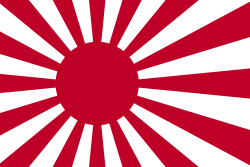
Military and social organizations
Important institutional links existed between the Party in Government (Kodoha) and Military and Political Organizations like the Imperial Young Federation, and the "Political Department" of the Kempeitai; Amongst the himitsu kessha (secret societies), the Kokuryu-kai (Black Dragon Society), and Kokka Shakai Shugi Gakumei (the National Socialist League) also had close ties to the government. The Tonarigumi (residents committee) groups, the Nation Service Society (national government trade union) and Imperial Farmers Association were all allied as well. See more: List of Japanese institutions (1930 - 1945)
Other organizations and groups related with the government in wartime were: Double Leaf Society, Kokuhonsha, Taisei Yokusankai, Imperial Youth Corps, Tokko, Tokeitai, Keishicho (to 1945), Shintoist Rites Research Council, Treaty Faction, Fleet Faction and Imperial Volunteer Corps
Nationalistic factors
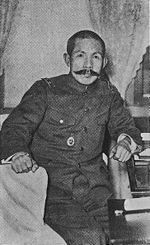
Sadao Araki was an important figurehead and founder of the Army party and the most important right-wing thinker in his time. His first ideological works date from his leadership of the Kodaha (Imperial Benevolent Rule or Action Group), opposed by the Toseiha (Control Group) led by General Kazushige Ugaki. He linked the ancient (bushido code) and contemporary local and European fascist ideals (see Japanese fascism), to form the ideological basis of the movement (Shōwa nationalism).
From September 1932, the Japanese were becoming more locked into the course that would lead them into the Second World War, with Araki leading the way. Totalitarianism, militarism and expansionism were to become the rule, with fewer voices able to speak against it. In a September 23 news conference, Araki first mentioned the philosophy of "Kodoha" (The Imperial Way Faction). The concept of Kodo linked the Emperor, the people, land and morality as indivisible. This led to the creation of a "new" Shinto and increased Emperor worship.
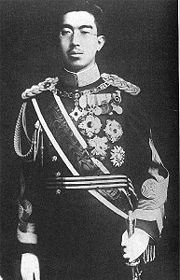
The state was being transformed to serve the Army and the Emperor. Symbolic katana swords came back into fashion as the martial embodiment of these beliefs, and the Nambu pistol became its contemporary equivalent, with the implicit message that the Army doctrine of close combat would prevail. The final objective, as envisioned by Army thinkers and right-wing line followers, was a return to the old Shogunate system, but in the form of a contemporary Military Shogunate. In such a government the Emperor would once more be a figurehead (as in the Edo period). Real power would fall to a leader very similar to a Führer or Duce, though with the power less nakedly held. On the other hand, the traditionalist Navy militarists defended the Emperor and a constitutional monarchy with a significant religious aspect.
A third point of view was supported by Prince Chichibu, a brother of Emperor Shōwa, who repeatedly counseled him to implement a direct imperial rule, even if that meant suspending the constitution.[14]
With the lauching of the Imperial Rule Assistance Association in 1940 by Prime minister Fumimaro Konoe, Japan would turn to a form of government that resembled Totalitarianism. However, although this unique style of government was very similar to Fascism there were many significant differences between the two and therefore could be termed Japanese nationalism.
Economic factors
At same time, the zaibatsu capitalist groups (principally Mitsubishi, Mitsui, Sumitomo, and Yasuda) looked toward great future expansion. Their main concern was a shortage of raw materials. Prime Minister Fumimaro Konoye combined social concerns with the needs of capital, and planned for expansion.
The main goals of Japan's expansionism were acquisition and protection of spheres of influence, maintenance of territorial integrity, acquisition of raw materials, and access to Asian markets. Western nations, notably Great Britain, France, and the United States, had for long exhibited great interest in the commercial opportunities in China and other parts of Asia. These opportunities had attracted Western investment because of the availability of raw materials for both domestic production and re-export to Asia. Japan desired these opportunities in planning the development of the Greater East Asian Co-Prosperity Sphere.

The Great Depression, just as in many other countries, had hindered Japan's economic growth. The Japanese Empire's main problem lay in that rapid industrial expansion had turned the country into a major manufacturing and industrial power that required raw materials; however, these could only be obtained overseas as there was a critical lack of natural resources on the home islands.
In the 1920s and 1930s Japan needed to import raw materials such as iron, rubber and oil to maintain strong economic growth. Most of these resources however came from the United States. The Japanese felt that acquiring resource-rich territories would establish economic self-sufficiency and independence, and they also hoped to jump-start the nation's economy in the midst of the depression. As a result Japan set its sights on East Asia, specifically Manchuria with its many resources; Japan needed these resources to continue its economic development and maintain national integrity.
Once outright war began, the Domei Tsushin Press Agency celebrated the quality of Japan's armaments, stating that Mitsubishi and the others had taken the measure of the "white barbarians".
Early Shōwa (1937-1945) - Expansionism
Pre-War Expansionism
Manchuria


With little resistance, Japan invaded and conquered Manchuria in 1931. Japan claimed that this invasion was a liberation of the Manchus from the Chinese, although the majority of the population were Han Chinese. Japan then established a puppet regime called Manchukuo, and installed the former Emperor of China, Puyi, as the official head of state. Jehol, a Chinese territory bordering Manchuria, was also taken in 1933. This puppet regime had to carry on a protracted pacification campaign against the Anti-Japanese Volunteer Armies in Manchuria. In 1936, Japan created a similar Mongolian puppet state in Inner Mongolia named Mengjiang (Chinese: 蒙疆) which was again predominantly Chinese.
Second Sino-Japanese War
Japan invaded China in 1937, creating what was essentially a three-way war between Japan, Mao Zedong's communists, and Chiang Kai-shek's nationalists. On 13 December that same year, the Nationalist capital of Nanking fell to Japanese troops. In the event known as the Rape of Nanking, Japanese troops massacred a large number of city's population. It is estimated that nearly 300,000 people, almost entirely civilians, were killed, though the figure varies depending upon the source. In total, 20 million Chinese, mostly civilians, would be killed during World War II. A puppet state was also set up in China quickly afterwards, headed by Wang Jingwei. The second Sino-Japanese war would continue into World War II with the Communists and Nationalists in a temporary and uneasy alliance against the Japanese.
Clashes with the Soviet Union
The Battle of Lake Khasan was an attempted military incursion of the Japanese 19th Division into the territory claimed by the Soviet Union. This incursion was founded in the belief of the Japanese that the Soviet Union misinterpreted the demarcation of the boundary based on the Treaty of Peking between Imperial Russia and Manchu China (and subsequent supplementary agreements on demarcation), and furthermore, that the demarcation markers were tampered with.
The following year, Nomonhan Incident (Battle of Khalkhin Gol) occurred on 11 May 1939, when a Mongolian cavalry unit of some 70 to 90 men entered the disputed area in search of grazing for their horses, and encountered Manchukuoan cavalry who drove them out of the disputed territory. Two days later the Mongolian force returned and the Manchukoans were unable to evict them.
The Japanese IJA 23rd Division and other units of the Kwantung Army then became involved. Joseph Stalin ordered STAVKA, the Red Army's high command, to develop a plan for a counterstrike against the Japanese. Georgy Zhukov led a devastating offensive employing encircling tactics making skillful use of their superior artillery, armor and air forces in late August that nearly annihilated the 23rd Division and decimated the IJA 7th Division. On September 15 an armistice was arranged. Nearly two years later, on April 13, 1941, the parties signed a Neutrality Pact, in which they agreed to abide by the existing border.
Tripartite Pact

The Second Sino-Japanese War had seen tensions rise between Imperial Japan and the United States; events such as the Panay incident and the 'Rape of Nanking' turned American public opinion against Japan. With the occupation of French Indochina in the years of 1940/41 and the continuing war in China, the United States embargoed strategic materials such as scrap metal and oil to Japan, which were vitally needed for their war effort. The Japanese were faced with the option of either withdrawing from China and losing face or seizing and securing new sources of raw materials in the resource rich, European controlled colonies of South East Asia — specifically British Malaya and the Dutch East Indies
On September 27, 1940, Imperial Japan signed the Tripartite Pact with Nazi Germany and Fascist Italy, their objectives to "establish and maintain a new order of things" in their respective world regions and spheres of influence; with Nazi Germany in Europe, Imperial Japan in Asia and Fascist Italy in North Africa. The signatories of this alliance become known as the Axis Powers. The pact also called for mutual protection—if any one of the member powers was attacked by a country not already at war, excluding the Soviet Union, and for technological and economic cooperation between the signatories.
On 31 December 1940, Matsuoka Yosuke told a group of Jewish businessmen that he was "the man responsible for the alliance with Hitler, but nowhere have I promised that we would carry out his anti-Semitic policies in Japan. This is not simply my personal opinion, it is the opinion of Japan, and I have no compunction about announcing it to the world."
Pacific War
Attack on Pearl Harbor

After facing an oil embargo by the United States and its own reserve oil supply about to run short, the Japanese government decided to take action and execute a plan developed by the military branch largely lead by Osami Nagano and Isoroku Yamamoto to bomb the United States naval base in Hawaii, thereby bringing the United States to World War II on the side of Allies. On 4 September 1941, the Japanese Cabinet met to consider the war plans prepared by Imperial General Headquarters, and decided:
Our Empire, for the purpose of self-defence and self-preservation, will complete preparations for war ... [and is] ... resolved to go to war with the United States, Great Britain and the Netherlands if necessary. Our Empire will concurrently take all possible diplomatic measures vis-a-vis the United States and Great Britain, and thereby endeavor to obtain our objectives ... In the event that there is no prospect of our demands being met by the first ten days of October through the diplomatic negotiations mentioned above, we will immediately decide to commence hostilities against the United States, Britain and the Netherlands.
The Imperial Japanese Navy made its surprise attack on Pearl Harbor, Oahu, Hawaii, on the Sunday morning of December 7, 1941. The Pacific Fleet of the United States Navy and its defending Army Air Forces and Marine air forces sustained significant losses. The primary objective of the attack was to incapacitate the United States long enough for Japan to establish its long-planned Southeast Asian empire and defensible buffer zones. The U.S. public saw the attack as a treacherous act and rallied against the Empire of Japan. The United States entered the European Theatre and Pacific Theater in full force. Four days later, Adolf Hitler of Nazi Germany declared war on the United States, bringing the separate conflicts into a cohesive conflict.
Japanese offensives (1941-42)
-
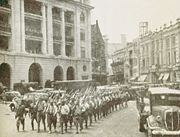 Victorious Army troops march through Singapore (Photo from Imperial War Museum)
Victorious Army troops march through Singapore (Photo from Imperial War Museum)
Following the attack on Pearl Harbor, the Japanese launched offensives against Allied forces in South East Asia, with simultaneous attacks on Hong Kong, British Malaya and the Philippines.
In Malaya, the Japanese overwhelmed a Commonwealth army composed of British, Indian, Australian and Malay forces. The Japanese were quickly able to advance down the Malayan peninsula, forcing the Commonwealth forces to retreat towards Singapore. The British lacked aircover and tanks; the Japanese had total air superiority. The sinking of H.M.S Prince of Wales and H.M.S Repulse on December 10, 1941 led to the east coast of Malaya being exposed to Japanese landings and the elimination of British naval power in the area. By the end of January 1942, the last Allied forces crossed the straight of Johore and into Singapore. Hong Kong surrendered to the Japanese on Christmas Day.

In the Philippines the Japanese pushed the combined Filipino-American force towards the Bataan peninsula and later the island of Corregidor. By January 1942 General Douglas MacArthur and President Manuel L. Quezon were forced to flee in the face of Japanese advance. This marked among one of the worst defeats suffered by the Americans, leaving over 70,000 American and Filipino prisoners of war in the custody of the Japanese.
On February 15, 1942 Singapore fell to the Japanese, resulting in the largest surrender of British-led military personnel in history. About 80,000 Indian, Australian and British troops became prisoners of war, joining 50,000 taken in the Japanese invasion of Malaya.
The Japanese then pushed into Burma, the Dutch East Indies and the South Pacific.
Path to defeat (1942-45)
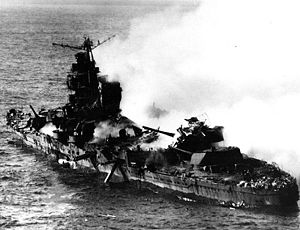
Japanese military strategists were keenly aware of the unfavorable discrepancy between the industrial potential of the Japanese Empire and that of the United States. Because of this they reasoned that Japanese success hinged on their ability to extend the strategic advantage gained at Pearl Harbor with additional strategic victories. Only decisive destruction of the United States' Pacific Fleet and conquest of its remote outposts would ensure that the Japanese Empire was not overwhelmed by America's industrial might. In May 1942, failure to decisively defeat the Allies at the Battle of Coral Sea in spite of Japanese numerical superiority equated to a strategic defeat for Imperial Japan. This setback was followed in June 1942 by the catastrophic loss of a four carrier task force at the Battle of Midway. Midway was a decisive defeat for the Imperial Japanese Navy, and proved the turning point for the war. Further defeats by the Allies at Guadalcanal in September 1942, and New Guinea in 1943 put the Empire of Japan on the defensive for the remainder of the war. By 1943 and 1944, Allied forces, backed by the industrial might and rich resources of the United States, were advancing steadily towards Japan. The US Sixth Army led by General MacArthur landed on Leyte on 19 October 1944, in the subsequent months (Philippines campaign of 1944–1945) American troops together with the Filipino soldiers and guerrilla forces liberated much of the Philippines. By 1944 the Allies had seized or bypassed and neutralized many of Japan's strategic bases through amphibious landings and bombardment. This, coupled with the losses inflicted by Allied submarines on Japanese shipping routes began to strangle Japan's economy and undermine its ability to supply its army. By early 1945 the US Marines had wrested control of the Ogasawa Islands in several hard-fought battles such as the Battle of Iwo Jima, marking the beginning of the fall of the islands of Japan.

Atomic bombings of Hiroshima and Nagasaki
After securing airfields in Saipan and Guam in the summer of 1944, the United States undertook an aggressive campaign of carpet bombing Japanese cities in an effort to pulverize Japan's industry and shatter its morale. While these campaigns led to the deaths of hundreds of thousands of civilians they did not succeed in persuading the Japanese to surrender. In the summer of 1945, the United States dropped two nuclear weapons on Japan. The atomic bombings were the first and last used against another nation. These bombs killed around 100,000 to 200,000 people in a matter of minutes, and many more people died as a result of nuclear radiation in the following weeks, months, and years.

Defeat and surrender
Having ignored (mokusatsu) the Potsdam Declaration, the Empire of Japan surrendered and ended World War II, after the atomic bombings of Hiroshima and Nagasaki and a declaration of war by the Soviet Union. In a national radio address of 15th August, Emperor Showa announced the surrender to the Japanese people.
After World War II
War crimes
Many political and military Japanese leaders were convicted for war crimes before the Tokyo tribunal and other Allied tribunals in Asia. However, all members of the imperial family implicated in the war, such as emperor Showa and his brothers, cousins and uncles such as Prince Chichibu, Prince Hiroyasu Fushimi and Prince Asaka, were exonerated from criminal prosecutions by Douglas MacArthur.
The Japanese before and during World War II committed numerous atrocities against civilian and military personnel. Large scale massacres, rapes and looting against civilians were committed most notably the Sook Ching and Nanking massacres (commonly known as "The Rape of Nanking"), with the latter having an estimated 300,000 non-combatant deaths. The Japanese also engaged in the execution and harsh treatment of Allied military personnel and POWs and biological experiments were conducted by Unit 731 on civilians and prisoners of war; this included the use of biological and chemical weapons on the Chinese populace resulting in the deaths of possibly as many as 200,000.
The use of "comfort women", who were forced to serve as prostitutes for the Japanese military. Many historians believe that an estimated 200,000 women were taken as comfort women during the reign.[15]
The International Military Tribunal for the Far East was formed to try Japanese war criminals.
Regime change
A period known as Occupied Japan followed after the war largely spearheaded by United States General of the Army Douglas McArthur to revise the Japanese constitution and de-militarize Japan. The American occupation, with economic and political assistance, continued well into the 1950s. After the dissolution of the Empire of Japan, Japan adopted a parliamentary-based political system, with the Emperor changed to symbolic status.
American General of the Army Douglas MacArthur later commended the new Japanese government that he helped established and the new Japanese period when he was about to send the American forces to the Korean War:
The Japanese people, since the war, have undergone the greatest reformation recorded in modern history. With a commendable will, eagerness to learn, and marked capacity to understand, they have, from the ashes left in war's wake, erected in Japan an edifice dedicated to the supremacy of individual liberty and personal dignity; and in the ensuing process there has been created a truly representative government committed to the advance of political morality, freedom of economic enterprise, and social justice. Politically, economically, and socially Japan is now abreast of many free nations of the earth and will not again fail the universal trust... I sent all four of our occupation divisions to the Korean battlefront without the slightest qualms as to the effect of the resulting power vacuum upon Japan. The results fully justified my faith. I know of no nation more serene, orderly, and industrious, nor in which higher hopes can be entertained for future constructive service in the advance of the human race.
For historian John W. Dower, however, "In retrospect, apart from the military officer corps, the purge of alleged militarists and ultranationalists that was conducted under the Occupation had relatively small impact on the long-term composition of men of influence in the public and private sectors. The purge initially brought new blood into the political parties, but this was offset by the return of huge numbers of formerly purged conservative politicians to national as well as local politics in the early 1950s. In the bureaucracy, the purge was negligible from the outset (...) In the economic sector, the purge similarly was only mildly disruptive, affecting less than sixteen hundred individuals spread among some four hundred companies. Everywhere one looks, the corridors of power in postwar Japan are crowded with men whose talents had already been recognized during the war years, and who found the same talents highly prized in the "new" Japan."[16]
Influential personnel
Political
In the administration of Japan dominated by the military political movement during World War II, the civil central government was under the management of military men and their right-wing civilian allies, along with members of the nobility and Imperial Family. The Emperor was in the center of this power structure as supreme Commander-in-Chief of the Imperial Armed Forces and head of state.




Military
The military of Imperial Japan was divided into two main branches under Imperial General Headquarters responsible for the overall conduct of operations including prominent military leaders and commanders:
- Prominent generals and leaders:
-
- Imperial Japanese Navy: Navy of Japan
- Admiral Count Sukeyuki Ito (1843–1914)
- Admiral Viscount Yoshika Inoue (1845–1929)
- Admiral Marquis Heihachiro Togo (1847–1934) Battle of Tsushima
- Admiral Prince Takahito Arisugawa (1862–1913)
- Admiral Baron Goro Ijuin (1852–1921)
- Admiral Prince Yorihito Higashi-Fushimi (1867–1922)
- Admiral Baron Hayao Shimamura (1858–1923)
- Admiral Baron Tomozaburo Kato (1861–1923)
- Admiral Prince Hiroyasu Fushimi (1876–1946)
- Admiral Isoroku Yamamoto (1884–1943) Battle of Midway, Attack on Pearl Harbor
- Admiral Osami Nagano (1880–1947)
- Admiral Mineichi Koga (1885–1944)
- Vice Admiral Chuichi Nagumo: Battle of Midway, Attack on Pearl Harbor
- Imperial Japanese Navy: Navy of Japan
-
- Imperial Japanese Army: Army of Japan
- Kotohito Kan'in: Chief of staff of the Army
- Hajime Sugiyama: Chief of staff of the Army
- Iwane Matsui: Second Sino-Japanese War
- Shunroku Hata: Commander of the expeditionary army in China
- Yasuji Okamura: Commander of the Sanko sakusen
- Tadamichi Kuribayashi: Battle of Iwo Jima
- Kuniaki Koiso: Prime Minister of Japan
- Hideki Tojo: Prime Minister of Japan
- Mitsuru Ushijima: Battle of Okinawa
- Imperial Japanese Army: Army of Japan
Timeline
- 1926: Emperor Taishō dies (December 25).
- 1927: Tanaka Giichi becomes prime minister (April 20).
- 1928: Emperor Shōwa is formally installed as emperor (November 10).
- 1929: Hamaguchi Osachi becomes prime minister (July 2).
- 1930: Hamaguchi is wounded in an assassination attempt (November 14).
- 1931: Hamaguchi dies and Wakatsuki Reijiro becomes prime minister (April 14). Japan occupies Manchuria after the Mukden Incident (September 18). Inukai Tsuyoshi becomes prime minister (December 13) and increases funding for the military in China.
- 1932: After an attack on Japanese monks in Shanghai (January 18), Japanese forces shell the city (January 29). Manchukuo is established with Henry Pu Yi as emperor (February 29). Inukai is assassinated during a coup attempt and Saito Makoto becomes prime minister (May 15). Japan is censured by the League of Nations (December 7).
- 1933: Japan leaves the League of Nations (March 27).
- 1934: Okada Keisuke becomes prime minister (July 8). Japan withdraws from the Washington Naval Treaty (December 29).
- 1936: Coup attempt (February 26 Incident). Hirota Koki becomes prime minister (March 9). Japan signs its first pact with Germany (November 25) and occupies Tsingtao (December 3). Mengchiang established in Inner Mongolia.
- 1937: Hayashi Senjuro becomes prime minister (February 2). Prince Konoe Fumimaro becomes prime minister (June 4). Battle of Lugou Bridge (July 7). Japan captures Beijing (July 31). Japanese troops occupy Nanjing (December 13), beginning the Nanjing massacre.
- 1938: Battle of Taierzhuang (March 24). Canton falls to Japanese forces (October 21).
- 1939: Hiranuma Kiichiro becomes prime minister (January 5). Abe Nobuyuki becomes prime minister (August 30).
- 1940: Yonai Mitsumasa becomes prime minister (January 16). Konoe becomes prime minister for a second term (July 22). Hundred Regiments Offensive (August–September). Japan occupies Indochina in the wake of the fall of Paris, and signs the Tripartite Pact (September 27).
- 1941: General Tojo Hideki becomes prime minister (October 18). Japanese naval forces attack Pearl Harbor, Hawaii (December 7), prompting the United States to declare war on Japan (December 8). Japan conquers Hong Kong (December 25).
- 1942: Singapore surrenders to Japan (February 15). Japan bombs Australia (February 19). Doolittle Raid on Tokyo (April 18). Battle of the Coral Sea (May 4–May 8). U.S. and Filipino forces in the Battle of the Philippines (1942) surrender (May 8). Japan defeated at the Battle of Midway (June 6). Allied victory in the Battle of Milne Bay (September 5).
- 1943: Allied victory in Battle of Guadalcanal (February 9). Japan defeated at Battle of Tarawa (November 23).
- 1944: Tojo resigns and Koiso Kuniaki becomes prime minister (July 22).
- 1945: U.S. bombers begin firebombing of major Japanese cities. Japan defeated at Battle of Iwo Jima (March 26). Admiral Suzuki Kantaro becomes prime minister (April 7). Japan defeated at Battle of Okinawa (June 21). U.S. drops atomic bombs on Hiroshima (August 6) and Nagasaki (August 9). Japan surrenders (August 14): Allied occupation begins.
Emperors of the Empire of Japan
| Posthumous name1 | Given name² | Childhood name³ | Period of Reigns | Era name4 | |
|---|---|---|---|---|---|
| Meiji Tennō (明治天皇) |
Mutsuhito (睦仁) |
Sachi-no-miya (祐宮) |
1867–1912 (1890-1912)5 |
Meiji | |
| Taishō Tennō (大正天皇) |
Yoshihito (嘉仁) |
Haru-no-miya (明宮) |
1912–1926 | Taishō | |
| Shōwa Tennō (昭和天皇) |
Hirohito (裕仁) |
Michi-no-miya (迪宮) |
1926–1989 (1926–1947)6 |
Shōwa | |
| 1 Each posthumous name was given after the respective era names as Ming and Qing Dynasties of China. | |||||
| 2 The Japanese imperial family name has no surname or dynastic name. | |||||
| 3 The Meiji Emperor was known only by the appellation Sachi-no-miya from his birth until 11 November 1860, when he was proclaimed heir apparent to Emperor Kōmei and received the personal name Mutsuhito . | |||||
| 4 No multiple era names were given for each reign after Meiji Emperor. | |||||
| 5 Constitutionally. | |||||
| 6 Constitutionally. The reign of the Shōwa Emperor in fact continued until 1989 since he did not abdicate after World War II. | |||||
This period includes the Meiji Era, the Taishō Era, and a part of the Shōwa Era.
< Edo period | History of Japan | Post-Occupation Japan >
References
Notes
- ↑ Hagiwara, p. 34.
- ↑ Jansen, pp. 314–5.
- ↑ Hagiwara, p. 35.
- ↑ Satow, p. 282.
- ↑ Keene, p. 116. See also Jansen, pp. 310–1.
- ↑ Keene, pp. 120–1, and Satow, p. 283. Moreover, Satow (p. 285) speculates that Yoshinobu had agreed to an assembly of daimyos on the hope that such a body would restore him to reinstate him.
- ↑ Satow, p. 286.
- ↑ During a recess, Saigō, who had his troops outside, "remarked that it would take only one short sword to settle the discussion" (Keene, p. 122). Original quotation (Japanese): "短刀一本あればかたづくことだ." in Hagiwara, p. 42. The specific word used for "dagger" was "tantō".
- ↑ Keene, p. 124.
- ↑ Keene, p. 340, notes that one might "describe the Oath in Five Articles as a constitution for all ages."
- ↑ The Secret of Japan's Strength www.calvin.edu
- ↑ - The Constitution of the Empire of Japan (1889)
- ↑ Hane, Mikiso, Modern Japan: A Historical Survey (Oxford: Westview Press, 1992) 234.
- ↑ Herbert Bix, Hirohito and the Making of Modern Japan, 2001, p.284
- ↑ BBC NEWS | Asia-Pacific | Abe questions sex slave 'coercion'
- ↑ J. W. Dower, Japan in War & Peace, New press, 1993, p.11
Books and Journals
- Jansen, Marius B. (2002). The Making of Modern Japan. Cambridge: Harvard University Press. ISBN 0-674-00991-6.
- Jansen, Marius B.; John Whitney Hall, Madoka Kanai, Denis Twitchett (1989). The Cambridge History of Japan. Cambridge University Press. ISBN 0521223563.
- Porter, Robert P. (2001). Japan: The Rise of a Modern Power. Adamant Media Corporation. ISBN 1402196903.
- Keene, Donald (2005). Emperor of Japan: Meiji and His World, 1852–1912. New York: Columbia. ISBN 0-231-12340-X.
- Satow, Ernest. A Diplomat in Japan. ISBN 4-925080-28-8.
- Lewis, John David (2007). 'Gifts from Heaven': The Meaning of the American Victory over Japan, 1945. 2. Glen Allen, VA: Glen Allen Press.
External links
|
|||||||||||||

